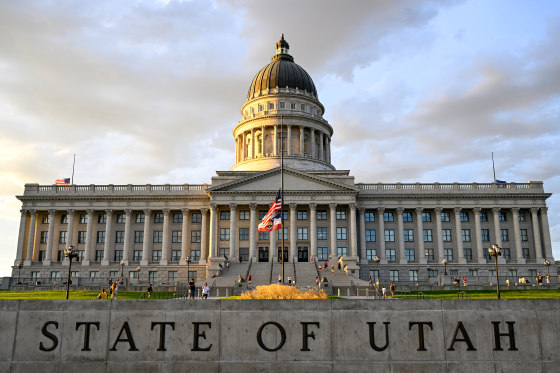Utah lawmakers passed new congressional district lines Monday that seek to protect the state's all-Republican delegation after a court ordered them to draw a new map ahead of next year's midterm elections.
Under the proposed map, Salt Lake County — the most Democratic part of Utah — would be split into two districts, rather than divided into the current four. Those two districts are expected to still lean Republican, but they could be more competitive for Democrats, while the two others in the state would remain solidly GOP.
The map, which a redistricting committee advanced Monday morning before the full Legislature passed it as part of special session later in the day, will still need to be signed by GOP Gov. Spencer Cox and approved by the district court that demanded new lines.
The court ruled in August that the state must follow a 2018 ballot measure called Proposition 4 passed by voters, which prohibited gerrymandering; required lawmakers to keep counties, cities and communities of interest together whenever possible; and draw compact districts.
The redistricting committee considered several maps before it recommended the one backed by the Utah GOP.
Utah Republicans defended their map in remarks that were heated at times Monday, arguing the courts were overstepping, forcing a rushed map-drawing process, and touting that their proposal would give multiple members rural and urban areas to represent. They noted that Salt Lake County cannot be its own district because of its size, with more than 1.18 million residents; federal law requires that all districts be the same size, with districts this decade encompassing about 761,169 voters apiece. Giving one district the bulk of Salt Lake City would have made the seat far more competitive for Democrats, who make up nearly 14% of all registered voters in the state.
State Sen. Lincoln Fillmore, a Republican from Salt Lake County on the redistricting committee, said they were urged not to consider partisan data — so much so he left a meeting once when partisan implications of redistricting was discussed.
"Even today, I have no idea what the partisan impacts of this map will be," he said, arguing that the map was driven by members solely focused on following the map-drawing parameters laid out in Proposition 4. "This specific map has checked all of those boxes."
The chosen map "is the least representative option of the maps they proposed. It was advanced using a narrow partisan bias test that limits how fairness is measured," said Elizabeth Rasmussen, executive director of Better Boundaries, the anti-gerrymandering group that advanced the ballot measure and is funding the litigation in defense of it.
The district court will soon review the Legislature’s map, as well as other maps submitted to the court by the plaintiff or third parties, before it approves one by Nov. 10, she said.
The Legislature’s vote is the latest chapter in a nationwide redistricting battle that has broken out in recent months. While Utah was required to draw a new map, President Donald Trump has pushed Republican lawmakers in states around the country to take up midcycle redistricting efforts to help protect the party’s narrow U.S. House majority in the 2026 elections.
Trump criticized the August court ruling, calling it “unconstitutional” on Truth Social at the time.
“How did such a wonderful Republican State like Utah, which I won in every Election, end up with so many Radical Left Judges? All Citizens of Utah should be outraged at their activist Judiciary, which wants to take away our Congressional advantage, and will do everything possible to do so,” he wrote.
In addition, Texas Republicans enacted a new map over the summer that could net their party as many as five House seats. California Democrats responded with a new map that seeks to offset those potential gains. Since the effort tries to circumvent the state's independent redistricting commission, voters will need to approve the map in November.
The Missouri Legislature passed a new congressional map last month that targets Democratic Rep. Emanuel Cleaver's district in Kansas City. Opponents are pursuing a referendum petition to put the change on the ballot.
In Ohio, Republicans are refusing to engage with Democrats in their bipartisan redistricting commission’s process, meaning they are required to draw new lines that could further boost the party.
Other states, including Indiana, Kansas, Florida and Maryland, are weighing mid-decade redistricting efforts, as well.

